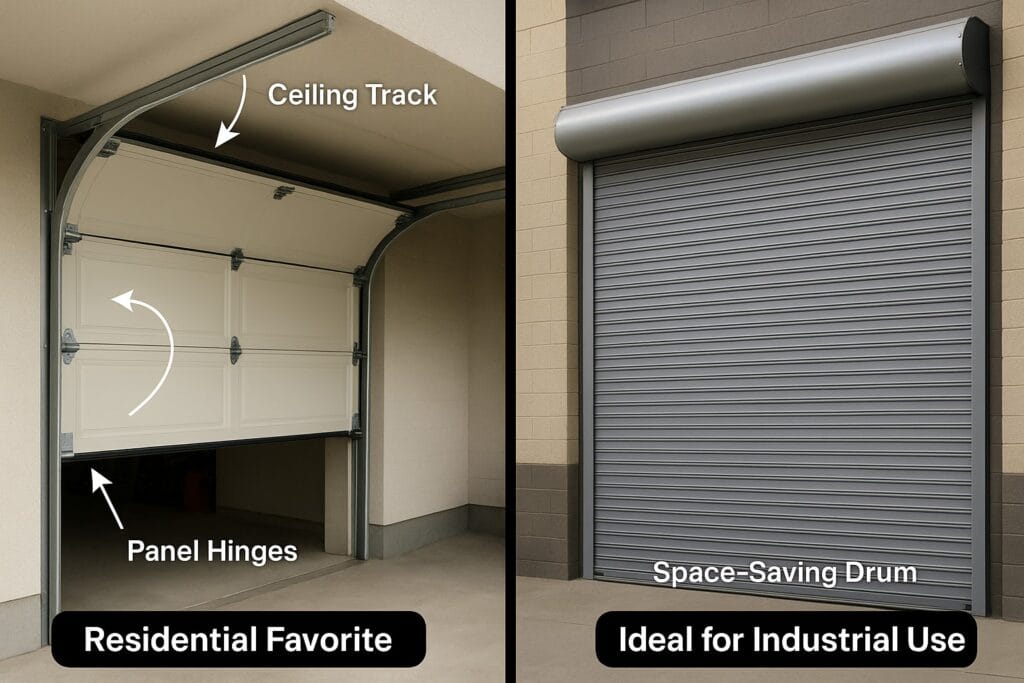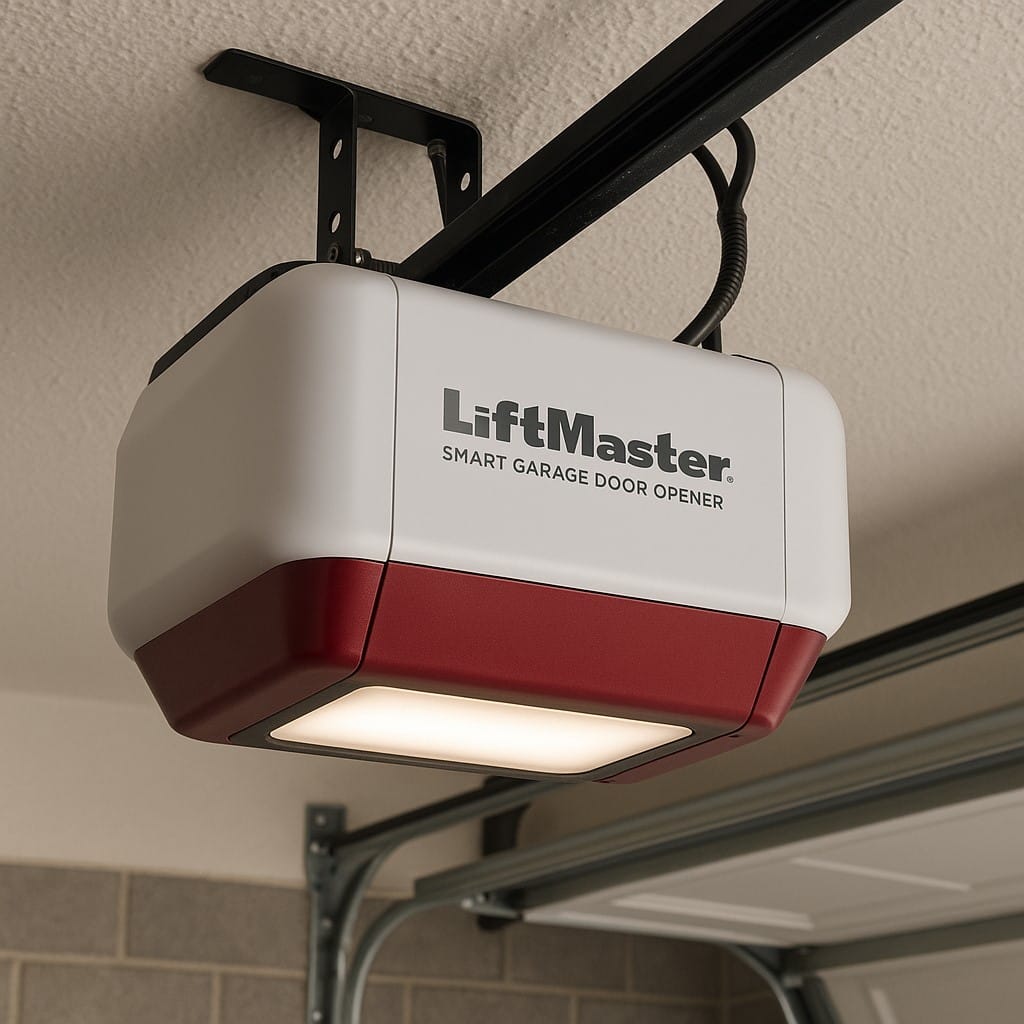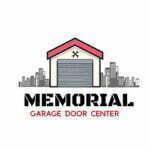Sectional Overhead Door vs Roll Up Garage Door: What to Install?

When a local business in the Houston Heights area contacted Memorial Garage Door Center about their aging, noisy roll-up door, they didn’t realize how much they were losing literally. Poor insulation led to rising energy bills, heat loss in the winter, and sweltering conditions in the summer. After evaluating their garage space and operations, our team installed a sectional insulated garage door with polyurethane foam panels, immediately improving temperature control and operational efficiency.
Did you know that around 55% of U.S. homeowners use their garage door as their primary entrance? And for commercial buildings, garage doors often serve as the first layer of security. Choosing the right garage door, whether it’s the sectional or roll-up garage door, isn’t just about aesthetics. It impacts insulation, energy efficiency, security, and functionality.
At Memorial Garage Door Center in Houston, TX, we specialize in helping homeowners and businesses choose the right garage door for their needs. In this guide, we’ll break down the key differences, benefits, drawbacks, and long-term implications of sectional overhead doors vs roll-up garage doors. Plus, we’ll share how proper insulation using materials like polyurethane, polystyrene, and aluminum can boost energy savings and provide a strong return on investment.
Understanding the Basics: Sectional vs Roll Up Garage Doors
What is a Sectional Overhead Door?
A sectional garage door consists of large panels connected by hinges. As the door opens, the panels bend and travel along a vertical track before sliding horizontally along the ceiling. These doors are common in residential properties and increasingly popular in commercial garages that require high insulation and customization.
What is a Roll Up Garage Door?
A roll-up garage door, also known as a coiling door, is made of narrower metal slats that roll into a compact drum above the opening. These are typically used in warehouses, loading docks, and storage units where durability and space-saving are priorities

Material Comparison: Steel, Aluminum, and Insulation Options
When comparing these two types, understanding the materials used is essential. Whether you’re installing a new garage door or replacing an old one, the material affects cost, durability, insulation, and efficiency.
Feature | Sectional Door | Roll Up Door |
Common Materials | Steel, aluminum, fiberglass | Steel, aluminum |
Insulation Options | Polyurethane, polystyrene, batt insulation | Minimal, often no insulation |
Energy Efficiency | High with insulated panels | Low to medium |
Aesthetic Options | Wide range of colors, windows, and panel styles | Limited design |
R-Value (Insulation Rating) | Up to R-18 or more | Typically R-4 to R-8 |
Polyurethane foam provides a higher R-value, making it ideal for energy-efficient insulated garage doors. Polystyrene panels offer a lower but still effective insulation value. For humid Houston weather, choosing the right insulation material can significantly reduce heat transfer, improve temperature control, and prevent garage door condensation.
Space and Layout Considerations
Sectional Doors:
These require garage ceiling space for tracks and storage. Homes with low headroom might need special track configurations. They are ideal for:
- Attached garages
- Garage workshops
- Homes with driveways
Roll Up Doors:
Because they coil into a drum above the door, roll-up doors are perfect for tight vertical spaces where ceiling clearance is limited. They’re excellent for:
- Industrial settings
- Retail warehouses
- Storage units
Durability and Maintenance
Roll Up Garage Doors:
Built for heavy-duty usage, roll-up doors often feature galvanized steel slats with minimal moving parts. They’re known for:
- Longevity
- Resisting weather damage
- Low maintenance
Sectional Overhead Doors:
While durable, these have more moving parts, hinges, rollers, and tracks, which require occasional maintenance. Still, they can last over 15 years with proper care, especially Craftsman, Amarr, Martin, and Clopay garage doors with rigid insulation and weather-resistant materials.
Noise Reduction and Insulation
Insulated sectional garage doors offer major noise reduction benefits, which is crucial if your garage is attached to living areas or used as a workshop. Insulated garage doors reduce:
- Noise from outside
- Vibration during operation
- Heat and cold transfer
Roll-up doors, unless specially designed, provide minimal noise and temperature buffering. However, some commercial models include urethane-coated slats for modest insulation and quieter use.
Cost Considerations: Initial vs Long-Term Investment
Initial Cost:
- Sectional doors: $1,000–$3,000 (depending on size, style, and insulation)
- Roll up doors: $1,500–$4,000 (more expensive upfront due to materials and installation)
Long-Term Costs:
- Sectional doors can reduce energy bills significantly if well-insulated.
- Roll-up doors save on maintenance and last longer under heavy use.
Your total cost of ownership will depend on usage, environment, and insulation. Choosing a garage door with a high R-value and durable insulation materials like Styrofoam, rigid foam, or batt insulation pays off over time.
Garage Door Openers and Smart Features
Both types of doors can be paired with modern garage door openers like Chamberlain or LiftMaster models. However:
- Sectional doors offer more compatibility with smart openers, allowing Wi-Fi control, Amazon Alexa integration, and logic board upgrades.
- Roll-up doors require heavy-duty openers, and smart integrations are more limited.

Aesthetic Flexibility
If curb appeal is important, sectional doors are the clear winner. They come in a variety of:
- Panel designs
- Color finishes
- Window styles
- Decorative hardware
For homes in areas like Memorial Park, The Heights, or West University, an insulated sectional door enhances the home’s value and appearance.
Pros and Cons Breakdown
Sectional Overhead Door – Pros & Cons
Pros:
- High insulation and R-value
- Custom designs and styles
- Quiet operation
- Energy efficient
Cons:
- Requires ceiling space
- More parts to maintain
Roll Up Garage Door – Pros & Cons
Pros:
- Space-saving
- Durable and secure
- Great for industrial use
- Low maintenance
Cons:
- Fewer design choices
- Limited insulation
- Higher upfront cost
What’s Best for Houston’s Climate?
With hot summers, humid weather, and seasonal storms, Houston homeowners benefit most from:
- Insulated sectional garage doors with polyurethane foam and sealed edges to minimize air transfer.
- Weather-resistant roll-up doors for commercial properties needing security and durability.
Non-insulated doors lead to energy loss, increased heat in summer, and poor temperature control, a problem easily solved with an insulated garage door kit.
How Can Memorial Garage Door Center Help You?
Choosing the right garage door isn’t easy, but Memorial Garage Door Center is here to help. Whether you’re in Midtown, Rice Military, or Downtown Houston, our experts are ready to install or replace your garage door with quality you can trust.
✅ What We Offer:
- Free evaluations and consultations
- Custom garage door installations
- Garage door insulation upgrades
- Emergency repair and maintenance
- Wide range of materials and brands, including Clopay, Amarr, Martin, and more
Our Houston-based technicians are trained to install both sectional and roll-up garage doors with an eye for energy efficiency, security, and style.
📍 Visit us at:
2417 Sabine St, Houston, TX 77007
📞 Call now:
(281) 720-3113
Ready to boost your home’s energy efficiency, security, and curb appeal? Contact Memorial Garage Door Center today and let’s get started on your new garage door installation done right the first time.
Frequently Asked Questions (FAQs)
1. Can I manually open a roll-up garage door during a power outage?
Yes, most roll-up garage doors include a manual chain hoist system or release mechanism for emergency access during power failures.
2. Which garage door type is better for hurricane-prone areas like Houston?
Roll-up doors made of reinforced steel are generally more wind-resistant, but hurricane-rated sectional doors with proper bracing are also highly effective.
3. Do roll-up garage doors come with insulation options?
Yes, but options are limited; some premium roll-up models offer light insulation with urethane or foam-filled slats, though not as effective as sectional door insulation.
4. How long does it take to install each type of garage door?
A sectional door typically takes 4–6 hours to install, while roll-up doors can take 6–8 hours, depending on the size and complexity of the opening.
